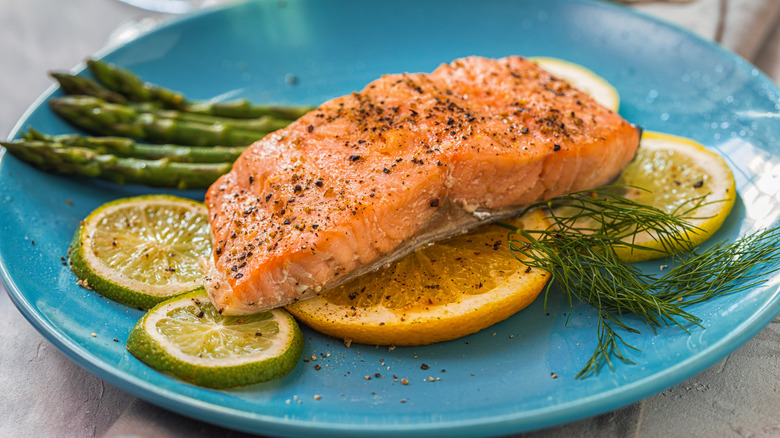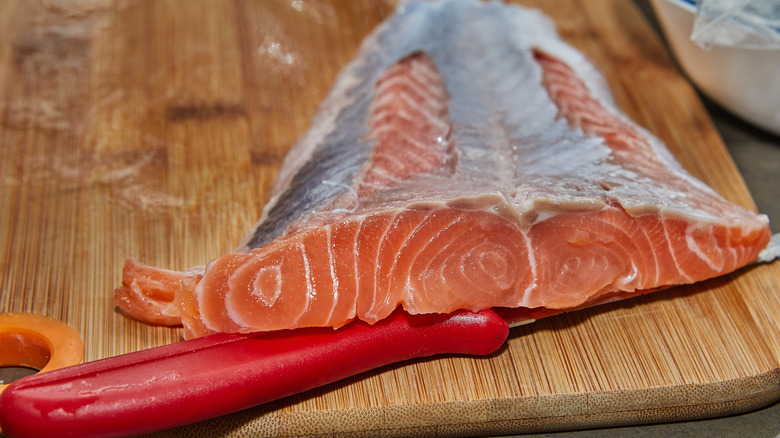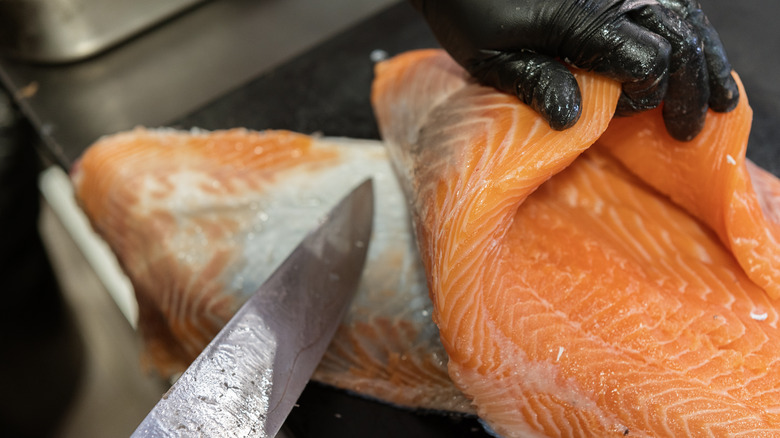What Is That Brown Or Gray Layer On Salmon?
Imagine you're about to slide your fork into a perfectly seared, mouthwatering salmon fillet. You pull back the shatteringly crisp salmon skin on top to peek at the flesh, but instead of a vibrant shade of coral, you find a less-than-enticing brown or gray layer. Picky diners might be tempted to scrape it off — but not only is this layer of flesh completely safe to eat, but it may become your new favorite part of the fish, if you give it a chance.
Also called the fat line, this brownish-gray bit is subcutaneous fat that sits between the skin and the muscle of the salmon. It serves biological purposes similar to our own subcutaneous fat: It keeps the fish warm in colder temperatures, and acts as a source of energy in between feedings. Some may find the hue off-putting, but it's a natural color change that results from oxygen exposure during processing and packaging.
Whether or not you eat the fat line comes down to personal preference. There is no harm in removing it, but you can reap some unique health and taste benefits if you leave it on. Much like when you sear a steak or duck breast, the extra fat in the salmon will render out as it cooks, imparting a lip-smacking unctuousness to the meat. The fat can keep the fillet from drying out, too. Plus, you'll miss out on lots of healthy fats and nutrients if you trim this layer.
Pros and cons of the fat line on salmon
The layer of gray fat on salmon happens to be rich in omega-3 fatty acids. According to the National Institutes of Health (NIH), there are many potential health benefits associated with omega-3s, including improved heart health and cognitive function, as well as possible anti-cancer properties. The fat line is also a good source of vitamin D, which is important for bone and immune system health, among other bodily processes, per the NIH.
In terms of taste, the fat line tends to have a fishier, more gamey flavor. Some diners covet this richness, but if you don't, it might be best to remove the gray layer and soak salmon in milk for a milder fish flavor. Omega-3 fatty acids also oxidize easily and can turn rancid if the salmon is not stored properly in an airtight vessel. Always store fish in airtight bags or containers in the fridge, and vacuum-seal it if you plan to freeze it, which will keep "off" flavors at bay.
There's another downside to the fat line: It could contain excess environmental toxins, depending on where your salmon comes from. Farm-raised fish are prone to this issue because their feed contains more contaminants, compared to their diets in the wild. These toxins often accumulate in the fatty tissue and can act as carcinogens in humans, says a study from Indiana University. Opting for wild-caught fish can help you reap those omega-3 benefits without ingesting all those contaminants.
How to remove the gray layer on salmon
If you don't wish to eat the gray layer on your salmon, you could scrape it off the raw fillet, but there is one cumbersome roadblock: the stubborn skin. Both the skin and fat line are much easier to remove after cooking the fish, compared to before. Once the flesh of the fish is cooked, the skin will be easy to slide off with a spatula; from there, simply scrape away the gray layer with the back of a knife or another flat-edged tool.
On the other hand, perhaps you're worried about mangling your fish after painstakingly cooking it, and you really want to remove the fat before cooking. If you buy your salmon at a fishmonger, you could ask them to remove the skin and fat line for you before you take your fillet home. If you tend to buy fish right from a supermarket cooler, there is one trick that helps the skin slide off easily with no knife skills or special tools involved. If you pour boiling water over salmon fillets, or any other fish fillet with the skin attached, removing that top layer becomes a seamless task. The hot water will help the skin slip right off in one piece, leaving the gray layer exposed and easy to slice right off.



